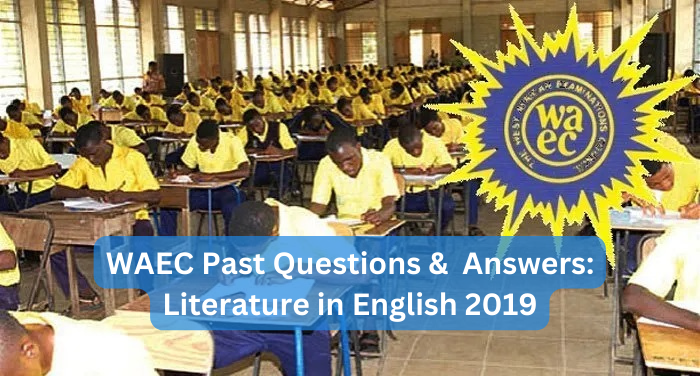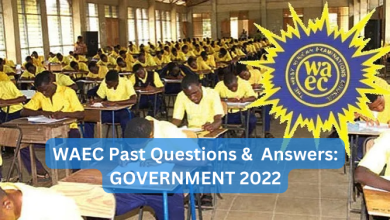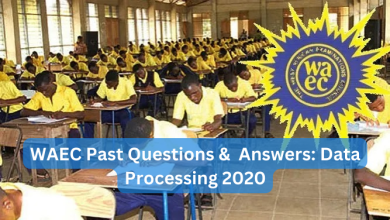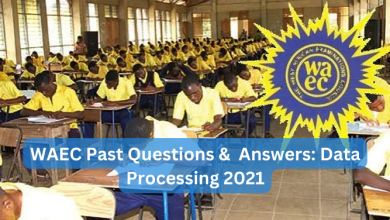WAEC Past Questions & Answer: Literature in English 2019

Welcome to our WAEC past question and answer series. In this post, we will be sharing Literature in English 2019 past questions and their answers for various subjects. Stay tuned enjoy while learning.
1. A literary work which is intended to teach a moral lesson is __________
A. romantic
B. didactic
C. mimetic
D. moralistic.
2. A short account of an interesting event is ________
A. a tale.
B. an anecdote
C. an episode.
D. a story
3. He is a citizen of no mean city illustrates _________
A. bathos
B. euphemism
C. metonymy
D. litotes
4. The introductory part of a play, a novel or a poem is the ________
A. epilogue
B. plot
C. setting
D. prologue
5. An elegy is a poem of ________
A. mourning
B. complain
C. hope
D. joy
6. The trees bowed their heads in shame illustrates ________
A. personification
B. alliteration
C. assonance
D. paradox
7. A character whose actions are predictable in a literary work is _________
A. round character
B. a flat character
C. the hero
D. the villain
8. A scene in fiction enacting past events is __________
A. allusion
B. foreshadow
C. flashback
D. interlude
9. Poetic licence is a term applied to a poet’s _______
A. choice of word
B. choice of characters
C. restrictions in the use of language
D. freedom in the use of language
10. Milton! thou shouldn’t be living at this hour.
The literary device used in the line above is _________
A. aside
B. apostrophe
C. soliloquy
D. suspense
11. Here lie I, Martin Eliginbrodde
Have mercy on my soul, Lord Gọd
The extract above illustrates ______
A. epitaph
B. elegy
C. ballad
D. dirge
12. We live to die, we die to live is an example of _________
A. paradox
B. hyperbole
C. inversion
D. Oxymoron
13. Read the poem and answer questions 13 to 15.
Here she lies, a pretty bud,
Lately made of flesh and blood;
Who as soon fell fast asleep
As her little eyes did peep.
Give her strewings, but not stir
The earth that lightly covers her.
The poem is about a/an ___________
A. flower
B. old woman
C. little child
D. traveller
14. The persona’s mood is one of ________
A. anger
B. admiration
C. indifference
D. joy
15. The, thyme pattern is ______
A. abc abc
B. aa bb cc
C. ab ab cc
D. aa bc bc
16. A play in which characters act through gestures and facial expressions is a _______
A. pantomime
B. burlesque
C. melodrama
D. farce
17. Characterisation refers to __________
A. how characters are grouped
B. the readers’ opinions of the characters
C. how characters are depicted
D. the roles played by the character
18. In a literary work, the foil is one who ________
A. Complements another character
B. contrasts with another character
C. introduces the conflict
D. resolves the conflict
19. Dramatis personae refers to ________
A. audience
B. characters
C. chorus
D. cast
20. A literary’ device used to enhance sound effect in poetry is __________
A. imagery
B. alliteration
C. refrain
D. symbol
21. Read the Passage and answer questions 21- 25.
Mark lies sleepless, his supine eyes rolling as he counts the rafters- vertically, horizontally, diagonally-over and over. There is continual rumbling in his belly. Lying so still, whom can he blame now? Isn’t it his own fault to be like this? Three months ago, Atongo and Agbenya said they were leaving town because “things have become too hard.” as they put it. They asked Mark to come along. He declined saying that he would have to prepare. Of course, he simply could not go-dare not. He had a pact with Akwele who sells kenkey downtown: neither could leave town without the other. At the time Mark’s friends were ready, Akwele had travelled to Accra and would, unknown to anyone, not return in a hurry. This is why Mark is lying dejected on his bed, a hungry man. Anyhow, he is not an angry man.
…supine eyes … illustrates _______
A. oxymoron
B. paradox
C. verbal irony
D. synecdoche.
22. Rumbling as used in the 1st paragraph is ______
A. onomatopoeic
B. metaphoric
C. ironic
D. alliterative
23. The dominant theme is ______
A. unrequited love
B. loss of opportunity
C. lack of trust.
D. insatiable hunger
24. The narrative technique is ________
A. third person
B. first person
C. interior-monologue
D. multiple narration.
25. The writer’s attitude is one of ________
A. anger
B. indifference
C. sympathy
D. mockery
26. Read the Poem and answer questions 26 to 30.
Walker, stop and let me move and check you
My sneaky, fleeting moon of reckless birth
The light of hope you flashed at dawn has dimmed
And flickers weakly, so you squint at Earth.
Walker, stand and let me sit and quiz you
Will foes and friends be irked if Mum you tell
The bitter tale of woe behind your flu?
The trickling tears unseen announce your age.
Walker, stay and let me come and tell you
My fleeting moon, I own you dim my light
Your sparkling blouse has turned a darker hue
You must, I guess, have done a steeplechase.
The stanzas are written in _________
A. quintets
B. quatrains
C. sestets
D. tercets
27. The recurrent device used is ________
A. synecdoche
B. apostrophe
C. metonymy
D. paradox
28. The mood of the poet is ________
A. derisive
B. ecstatic
C. regretful
D. melancholic
29. The opening lines of the stanzas are ________
A. trochaic
B. iambic
C. anapaestic
D. dactylic
30. The first stanza rhymes ______
A. ab ac
B. ab ab
C. abcb
D. abba
31. Read the extract and answer questions 31 to 35
When remedies are past, griefs are ended
By seeing the worst, which late on hopes depended.
To mourn a mischief that is past and gone
Is the next way to draw new mischief on.
What cannot be preserved when fortune takes,
Patience her injury a mock’ry makes.
The robbed that smiles. steals something from the thief’,
He robs himself that spends a bootless grief.
(Act I, Scene Three, lines 200 – 207) 31.
The speaker is ___________
A. Gratiano
B. Duke
C. Lodovico
D. Montano
32. The speech is directly addressed to __________
A. Cassio
B. Brabantio
C. Othello
D. 2nd Senator
33. The speech is about ________
A. Brabantio’s complaint about Othello.
B. Othello’s loss of his handkerchief
C. Brabantio’s loss of his daughter
D. the fight between Cassio and Roderigo
34. By the speech, the speaker attempts to __________
A. instigate the addressee
B. console the addressee
C. prevent a war
D. settle a fight
35. The underlined expression means ________
A. one is bound to lose something in life
B. keep smiling even while being robbed
C. it is useful not to bemoan one’s loss
D. the thief loses either way
36. Read the extract and answer questions 36 to 40.
Thou art sure of me. Go, make money. I have told thee
Often, and I retell thee again and again, I hate the Moor.
My cause is hearted: thine has no less reason. Let us be
conjuctive in our revenge against him. If thou canst
Cuckold him, thou dost thyself a pleasure, me a sport.
There are many events in the womb of time, which wi
be delivered. Traverse, go, provide thy money! We will
have more of this tomorrow. Adieu.
(Act I, Scene Three, lines 355-362) 36.
The speaker and the addrešsee are ___________
A. Lodovico and Roderigo
B. Clown and Lodovico
C. lago and Roderigo
D. lago and Clown.
37. What binds the speaker and addressee together is their _______
A. hatred for Othello
B. fear of Cassio
C. fear of Cassio
D. hatred for Brabantio
38. The addressee is enjoined to Go, make money for ___________
A. wooing Desdemona
B. enriching lago
C. placating Brabantio
D. rewarding Bianca
39. The underlined expression means ________
A. you have your way by making him angry
B. you gain ty making his wite
C. you will not be delighted at the result
D. you will have succeeded in seducing her
40. The speaker’s attitude to the addressee is one of ________
A. spite
B. envy
C. friendliness
D. intolerance
41. Read the extract and answer questions 41 to 45.
I have done the state some service, and they know’t.
No more of that. I pray you, in your letters,
When you shall these unlucky deeds relate.
Speak of me as I am. Nothing extenuate.
Nor set down aught in malice. Then must you speak
Of one that loved not wisely, but too well:
The speaker is __________
A. Othello
B. Gratiano
C. lago
D. Cassio
42. The setting is ___________
A. a street in front of the citadel
B. a street
C. the citadel
D. Desdemona’s chamber
43. The speaker is addressing _________
A. Duke and others
B. Emilia
C. the Senate
D. Lodovico and others
44. The speech is intended to _______
A. preserve the speaker’s reputation
B. express the speakers remorse
C. express the speaker’s acceptance of guilt
D. denounce the speaker’s enemies
45. Among these unlucky deeds. the immediate one is _________
A. he killing of Desdemona
B. declaring Desdemiona as unfaithful
C. refusing to listen to Emilia
D. the sacking of Cassio
46. Read the extract and answer questions 46 1o 50,
If after every tempest come such calms.
May the winds blow till they have wakened death,
And let the labouring bark climb hills of seas
Olympus-high, and duck again as low
As hell’s from heaven. If it were now to die,
‘T were now to be most happy: for I fear
My soul hath her content so absolute
That not another comfort like to this
Succeeds in unknown fate.
(Act II, Scene One, lines 179 – 187) 46.
The speaker is ________
A. Brabantio
B. Othello
C. Duke
D. Montano
47. The occasion is _________
A. Othello’s return from war
B. Othello’s departure for Cyprus
C. Montano expressing his delight after the tempest.
D. the defeat of the Turks.
48. The dominant images are associated with _______
A. love
B. nature
C. sailing
D. war
49. The scene reveals the speaker’s __________
A. fear of adventure
B. affection for his wife
C. suspicion
D. fulfilment as a warrior
50. The language of the extract is best described as _________
A. ironical
B. humorous
C. hyperbolical
D. sarcástie.
Answers To Questions
- B
- B
- D
- D
- A
- B
- C
- C
- D
- B
- D
- A
- B
- B
- B
- A
- D
- A
- B
- B
- C
- B
- B
- A
- C
- B
- B
- C
- B
- C
- B
- B
- A
- B
- C
- C
- A
- A
- B
- D
- A
- D
- D
- A
- A
- B
- A
- C
- D
- A





